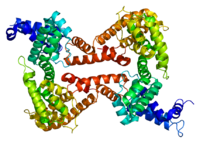
Photo from wikipedia
Background: Vitamin D-binding protein (VDBP) is a vital regulator of optimal vitamin D homeostasis and bioavailability. Apart from its well-documented role as a key component in vitamin D dynamic transfer… Click to show full abstract
Background: Vitamin D-binding protein (VDBP) is a vital regulator of optimal vitamin D homeostasis and bioavailability. Apart from its well-documented role as a key component in vitamin D dynamic transfer and circulation, it has a myriad of immunoregulatory functions related to innate immunity, which becomes particularly critical in states of increased immunological tolerance including pregnancy. In this regard, VDBP dyshomeostasis is considered to contribute to the development of several fetal, maternal, and neonatal adverse outcomes. However, precise physiological pathways, including the contribution of specific VDBP polymorphisms behind such phenomena, are yet to be fully deciphered. Our aim was to assess the combined effect of maternal and neonatal VDBP polymorphism heterogeneity in conjunction with different maternal and neonatal 25(OH)D cutoffs on the neonatal anthropometric profile at birth. Methods: The study included data and samples from a cohort of 66 mother–child pairs at birth. The inclusion criterion was full-term pregnancy (gestational weeks 37–42). Neonatal and maternal 25(OH)D cutoffs were included according to vitamin D status at birth and delivery. Concentrations of 25(OH)D2 and 25(OH)D3 were measured using liquid chromatography–tandem mass spectrometry. Results: The upper arm length of neonates with 25(OH)D ≤ 25 nmol/L was higher in neonate CC carriers for rs2298850. The upper thigh neonatal circumference was also higher in the ones with either 25(OH)D ≤ 50 or ≤75 nmol/L in rs2298850 CG + GG or rs4588 GT + TT carriers. We did not observe any significant effect for maternal VDBP polymorphisms nor for birth maternal 25(OH)D concentrations, on birth neonatal anthropometry. Conclusions: Our findings emphasize a potential role for neonatal VDBP genotypes rs2298850 and rs4588, in conjunction with specific neonatal 25(OH)D cutoffs, in the range of sufficiency on neonatal growth and development.
Journal Title: Nutrients
Year Published: 2022
Link to full text (if available)
Share on Social Media: Sign Up to like & get
recommendations!